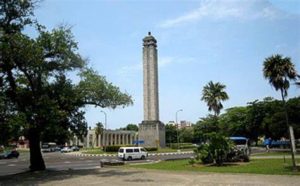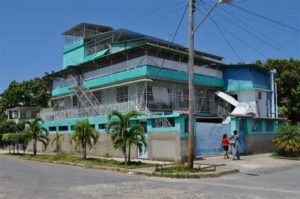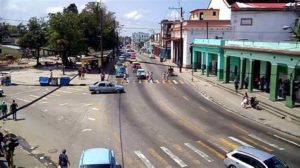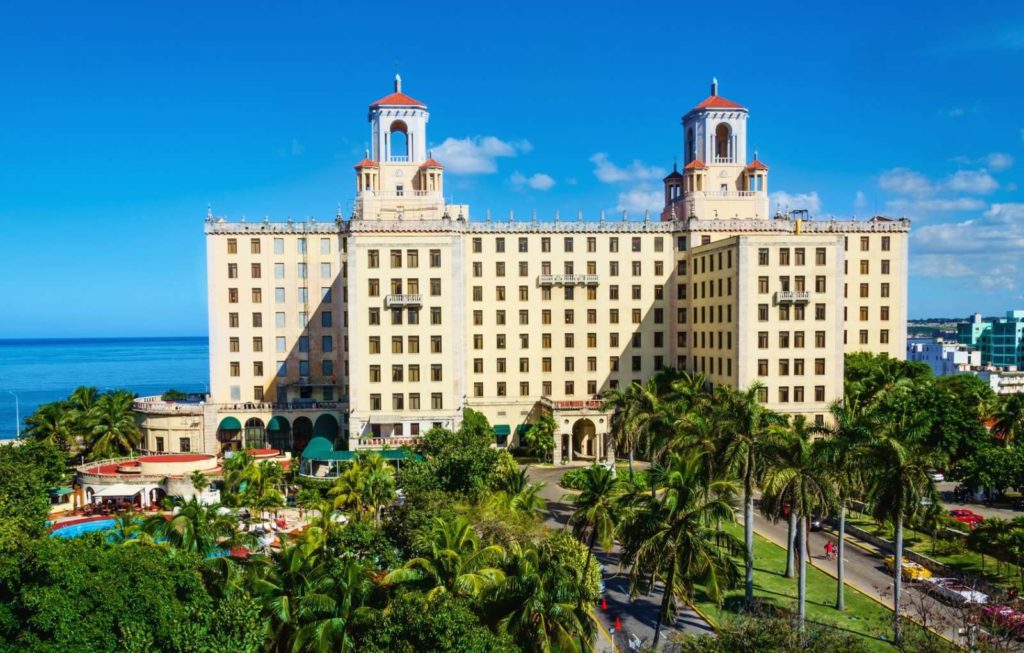MARIANAO, LA HABANA, CUBA CONOCIDA COMO “LA CIUDAD QUE PROGRESA”. PHOTOS.
Marianao es un municipio de la Provincia de La Habana (Cuba). Limita del suroeste al sureste con el municipio de Playa, del sureste al sur con el municipio de Boyeros y del sur al suroeste con el municipio de La Lisa.
Desde su constitución en municipio y hasta 1976 integraba también los mencionados municipios de Playa (Marianao norte) y La Lisa. Toda esta zona urbana estaba separada por el Río Almendares del antiguo municipio de La Habana, capital del país.
FUNDACION DE LA CIUDAD…
En los años 1500s y 1600s se asientan en la zona del actual Marianao los primeros colonos que se dedicaron a la ganadería primeramente y posteriormente a la actividad azucarera característica del resto de la Isla.
A principios de los años 1700s el ayuntamiento de La Habana otorga al presbítero Francisco Zayas Bazán unos terrenos como a tres leguas de la capital en los que dicho cura decide fundar un poblado. A tal efecto lleva a varios frailes de las órdenes Dominico, Agustina y Belemitas, quienes forman el primer caserío en 1719. En 1765 se nombra al poblado cabeza de partido con el nombre de Quemados de Marianao. Por esta ficha ya existía en el sitio una ermita. En 1789 se eleva su iglesia a parroquia bajo la advocación de San Francisco Javier.
Hacia finales de los años 1800s Marianao se convierte en el centro de reunión de las familias de La Habana que iban allí atraídas par la excelencia de las aguas del Pocito, un manantial del río Quibú cuyas aguas servían para el tratamiento de enfermedades del estómago, y también por los bailes y fiestas que se daban en la temporada de verano. Si a esto se suma la altura, su excelente clima y las brisas que lo envuelven, se comprende el por qué del favor público y la acelerada construcción de quintas y viviendas de buen gusto y excelente estructura, que fueron aumentando progresivamente a partir desde mitad de los 1800s.
En 1878 se constituye como municipio y adquiere auge industrial en la zona con la fabricación de productos de alfarería, cerámica, cemento, perfumes y otros artículos. En 1879 había en la ciudad 98 quintas de recreo junto a la carretera que iba de la capital a Guanajay. En 1884 se inaugura el tramo del ferrocarril hasta la Playa.
MARIANAO Y “LA DANZA DE LOS MILLONES”…
En 1902 el gobierno interventor norteamericano se dio a la tarea de realizar una nueva división territorial de la Isla, que modificó la existencia de numerosos ayuntamientos creados bajo la ley municipal de 1878, pero que en algunos casos no se ajustaban ya a las realidades geográficas, históricas y económicas de las distintas localidades. Al territorio de Marianao se incorporaron entonces los ayuntamientos de El Cano, Wajay y La Ceiba, lo cual elevó el área a 160 km².
Con el advenimiento de la etapa conocida como la “Danza de los Millones” entre 1914 y 1918, producida por el aumento del precio del azúcar como consecuencia de la Primera Guerra Mundial, se hicieron impresionantes inversiones en obras de urbanización de nuevas áreas y construcción de suntuosas residencias en Marianao. Se edificaron los repartos La Sierra, Céspedes y Ampliación de Miramar, la segunda ampliación del reparto Almendares y la urbanización del reparto Alturas del Río Almendares.
Asimismo se construyeron los repartos rústicos Country Club, hoy Cubanacán y la Coronela. A la par de este rediseño, las zonas bases de la población, como Pocito, Coco Solo, Los Quemados y barrios como Buenavista, Pogolotti, La Lisa, La Ceiba, que eran asientos de familias humildes, continuaban bajo el signo del atraso y la miseria. En estas localidades eran pésimos los escasos servicios públicos que se recibían.
En esta localidad, en los terrenos cercanos al Campamento de Columbia, desarrolló el científico cubano Carlos J. Finlay algunas de sus investigaciones fundamentales que lo llevaron al descubrimiento del agente trasmisor de la fiebre amarilla. Por ello existe, en la intersección de las calles 100 y 31, un gran obelisco dedicado a su memoria.
El establecimiento del campamento militar de Columbia en esta zona dio lugar al incremento de la actividad urbanística originándose densos núcleos de población en torno al mismo. En el período de 1903 a 1915 se construyeron los repartos: Columbia, Almendares, Santa Catalina de Buenavista, Larrazábal, San José, Jesús María, Los Hornos, Miramar, La Serafina, Clarisa y Oriental Park.
En el Campamento Columbia nace el 19 de diciembre de 1910 José Lezama Lima quien llegara a ser una de las figuras más importantes de la literatura cubana contemporánea junto con Alejo Carpentier, Virgilio Piñera, Eliseo Diego, Cintio Vitier, entre otros.
Hacia principios de los años de 1900s los jesuitas deciden construir un nuevo local del Colegio de Belén que funcionaba en La Habana Vieja. El lugar escogido fue el barrio de La Ceiba en el municipio de Marianao. El nuevo recinto se construyó al elevado precio de más de un millón y medio de dólares. En esta escuela cursó estudios Roberto Goizueta y Fidel Castro, quien la intervino el 3 de mayo de 1961 para convertirla en una academia militar.
A partir de 1945, continuó desarrollándose el movimiento urbanístico en Marianao, surgieron los repartos Alturas de Lasalle, Alturas de Belén y Alturas de la Lisa, El Náutico, Alturas del Bosque, Flores y Santa Felicia, Terrenos del Puente de La Lisa y Alturas de Marianao, El Palmar y Brisas de Marianao.
Durante la administración de Francisco Orúe, iniciada en 1948, gran parte de la población comenzó a levantar sus casas de lata y desperdicios en las márgenes del río Quibú (barrios de Pocito y Coco-Solo), debido a la pésima situación económica por la que atravesaban, surgiendo los llamados barrios de “llega y pon”.
DIVISION DEL MUNICIPIO…
En 1976, con la actual División Político-Administrativa de Cuba, el territorio del municipio de Marianao fue dividido en tres municipios:
– Playa, desde la orilla occidental del Río Almendares hasta la calle 76.
– Marianao, desde la calle 76 hasta el puente de La Lisa.
– La Lisa, desde el puente con el mismo nombre hasta los límites con la provincia de La Habana.
El municipio actual está compuesto administrativamente por los Consejos Populares de Los Quemados, Los Ángeles, Pocito, Palmar, Zamora, Cocosolo, Santa Felicia, Libertad, Pogolotti, Reparto Finlay, Curazao y Alturas de Belén.
Hasta el año 2002 en el municipio habitaban 549.469 personas. Con una tasa de desempleo promedio del 0,4%, más de 10 000 viviendas en estado regular o malo para lo que fue necesario realizar un proceso de intervención Urbanística del Municipio.
Existen en el Municipio 1789 discapacitados de ellos 482 encamados. Marianao cuenta con un centro de especialización para el cuidado y tratamiento de personas con retraso mental.
Al sur de su territorio, fuera del casco urbano se encuentra el Central Azucarero Manuel Martínez Prieto, único en la provincia, que en la actualidad se encuentra inactivo. El instituto de Investigaciones de la Caña de Azúcar. La fábrica de componentes electrónicos y ensamblaje conocido como COPEXTEL donde además se encuentran tres plantas de servicio de comunicaciones celular de fabricación italiana y varias plantas de procesamiento gráfico de alta tecnología. El Centro Nacional de Capacitación Informática del Ministerio de Comunicaciones, una instalación que incluye un hotel para los estudiantes.
También encontramos la Universidad Tecnológica de La Habana, conocida como la CUJAE, antiguo Instituto Superior Politécnico José Antonio Echeverría, primero de su tipo en el país.
Cuenta con la escuela clásica de Artes Plásticas conocida como San Alejandro y una dependencia del Ballet Nacional de Cuba que dirige la hija de Alicia Alonso, Laura Alonso, esta escuela es para niños, niñas y adolescentes con vocación para el ballet y con el conservatorio elemental de música Alejandro García Caturla.
La mayoría de la población creyente del municipio practica la religión afrocubana conocida como santería se dan excelentes bailes para los orishas en casas y solares que los marianenses disfrutan y participan, existen más de 55 babalawos consagrados y unas 30 casas de raíz religiosa. Se practica en el municipio la religión abbakua particularmente en los barrios de Pocito y Palmar donde existen tres plantes de diferentes raíces.
Marianao es el hogar del famoso Tropicana Club y fue sede del Hipódromo Oriental Park.
PERSONAS NOTABLES
Alicia Alonso, primera bailarina
Camilo Marin, agente jockey
María Teresa, Gran Duquesa de Luxemburgo, esposa del actual Gran Duque de Luxemburgo
Jorge Enrique González Pacheco, poeta y empresario cultural
Luis Tiant, beisbolista
MARIANAO, HAVANA, CUBA KNOWN AS “THE CITY THAT PROGRESSES”. PHOTOS.
Marianao is a municipality in the Province of Havana (Cuba). It limits from southwest to southeast with the municipality of Playa, from southeast to south with the municipality of Boyeros and from south to southwest with the municipality of La Lisa.
Since its constitution as a municipality and until 1976, it was also part of the aforementioned municipalities of Playa (Marianao Norte) and La Lisa. All this urban area was separated by the Almendares River from the old municipality of Havana, capital of the country.
FOUNDATION OF THE CITY…
In the 1500s and 1600s, the first settlers settled in the area of present-day Marianao, who dedicated themselves to cattle ranching first and later to the sugar activity characteristic of the rest of the Island.
At the beginning of the 1700s, the city council of Havana granted the priest Francisco Zayas Bazán some land about three leagues from the capital on which said priest decided to found a town. To this end, he takes several friars from the Dominico, Agustina and Belemitas orders, who form the first village in 1719. In 1765 the town is named head of the district with the name of Quemados de Marianao. By this file there was already a hermitage on the site. In 1789 its church was raised to a parish under the patronage of San Francisco Javier.
Towards the end of the 1800s, Marianao became the meeting place for families from Havana who went there attracted by the excellence of the waters of the Pocito, a spring of the Quibú River whose waters were used to treat stomach illnesses, and also for the dances and parties that took place in the summer season. If to this is added the height, its excellent climate and the breezes that surround it, it is understood why the public favor and the accelerated construction of villas and houses of good taste and excellent structure, which were progressively increasing from the middle of the 1800s.
In 1878 it was established as a municipality and acquired an industrial boom in the area with the manufacture of pottery, ceramics, cement, perfumes and other items. In 1879 there were 98 recreational villas in the city along the highway that went from the capital to Guanajay. In 1884 the section of the railway to the beach was inaugurated.
MARIANAO AND “THE DANCE OF THE MILLIONS”…
In 1902, the intervening North American government took on the task of carrying out a new territorial division of the Island, which modified the existence of numerous city councils created under the municipal law of 1878, but which in some cases no longer adjusted to the geographical realities, historical and economic of the different localities. The municipalities of El Cano, Wajay and La Ceiba were then incorporated into the territory of Marianao, which increased the area to 160 km².
With the advent of the stage known as the “Dance of the Millions” between 1914 and 1918, produced by the increase in the price of sugar as a result of the First World War, impressive investments were made in urbanization of new areas and construction of sumptuous residences in Marianao. The La Sierra, Céspedes and Ampliación de Miramar neighborhoods were built, the second expansion of the Almendares neighborhood and the urbanization of the Alturas del Río Almendares neighborhood.
Likewise, the rustic Country Club districts, today Cubanacán and La Coronela, were built. Along with this redesign, the base areas of the population, such as Pocito, Coco Solo, Los Quemados and neighborhoods such as Buenavista, Pogolotti, La Lisa, La Ceiba, which were seats of humble families, continued under the sign of backwardness and misery. In these localities, the few public services received were appalling.
In this locality, on land near the Columbia Camp, the Cuban scientist Carlos J. Finlay developed some of his fundamental research that led him to the discovery of the yellow fever transmitting agent. That is why there is, at the intersection of 100th and 31st streets, a large obelisk dedicated to his memory.
The establishment of the Columbia military camp in this area gave rise to an increase in urban activity, giving rise to dense population centers around it. In the period from 1903 to 1915 the distributions were built: Columbia, Almendares, Santa Catalina de Buenavista, Larrazábal, San José, Jesús María, Los Hornos, Miramar, La Serafina, Clarisa and Oriental Park.
José Lezama Lima was born in Camp Columbia on December 19, 1910, who would become one of the most important figures in contemporary Cuban literature along with Alejo Carpentier, Virgilio Piñera, Eliseo Diego, Cintio Vitier, among others.
Towards the beginning of the 1900s, the Jesuits decided to build a new location for the Colegio de Belén that used to function in Old Havana. The chosen place was the neighborhood of La Ceiba in the municipality of Marianao. The new venue was built at the high price of more than one and a half million dollars. Roberto Goizueta and Fidel Castro studied at this school, who intervened on May 3, 1961 to convert it into a military academy.
As of 1945, the urban development movement continued to develop in Marianao, with the emergence of the districts of Alturas de Lasalle, Alturas de Belén and Alturas de la Lisa, El Náutico, Alturas del Bosque, Flores and Santa Felicia, Terrenos del Puente de La Lisa and Alturas de la Lisa. Marianao, El Palmar and Brisas de Marianao.
During the administration of Francisco Orúe, which began in 1948, a large part of the population began to build their houses made of tin and rubbish on the banks of the Quibú River (Pocito and Coco-Solo neighborhoods), due to the dire economic situation for which they crossed, giving rise to the so-called “arrive and put” neighborhoods, so conducive to disease and vice.
DIVISION OF THE MUNICIPALITY…
In 1976, with the current Political-Administrative Division of Cuba, the territory of the municipality of Marianao was divided into three municipalities:
– Beach, from the western bank of the Almendares River to 76th Street.
– Marianao, from 76th Street to La Lisa Bridge.
– La Lisa, from the bridge with the same name to the limits with the province of Havana.
The current municipality is administratively composed of the Popular Councils of Los Quemados, Los Ángeles, Pocito, Palmar, Zamora, Cocosolo, Santa Felicia, Libertad, Pogolotti, Reparto Finlay, Curazao and Alturas de Belén.
Until the year 2002, 549,469 people lived in the municipality. With an average unemployment rate of 0.4%, more than 10,000 homes in fair or poor condition, for which it was necessary to carry out a process of urban planning intervention by the Municipality.
There are 1,789 disabled people in the municipality, 482 of whom are bedridden. Marianao has a specialized center for the care and treatment of people with mental retardation.
To the south of its territory, outside the urban area, is the Manuel Martínez Prieto Sugar Mill, the only one in the province, which is currently inactive. The Sugar Cane Research Institute. The electronic components and assembly factory known as COPEXTEL where there are also three Italian-made cellular communications service plants and several high-tech graphic processing plants. The National Computer Training Center of the Ministry of Communications, a facility that includes a hotel for students.
We also find the Technological University of Havana, known as the CUJAE, former José Antonio Echeverría Higher Polytechnic Institute, the first of its kind in the country.
It has the classic school of Plastic Arts known as San Alejandro and a dependency of the National Ballet of Cuba directed by the daughter of Alicia Alonso, Laura Alonso, this school is for children and adolescents with a vocation for ballet and with the elementary conservatory of music Alejandro García Caturla.
The majority of the believing population of the municipality practices the Afro-Cuban religion known as Santeria, there are excellent dances for the orishas in houses and lots that the Marianenses enjoy and participate in, there are more than 55 consecrated babalawos and about 30 houses of religious roots. The abbakua religion is practiced in the municipality, particularly in the neighborhoods of Pocito and Palmar, where there are three plants with different roots.
Marianao is home to the famous Tropicana Club and was home to the Oriental Park Racetrack.
NOTABLE PEOPLE
Alicia Alonso, prima ballerina
Camilo Marin, agent jockey
Maria Theresa, Grand Duchess of Luxembourg, wife of the current Grand Duke of Luxembourg
Jorge Enrique González Pacheco, poet and cultural entrepreneur
Luis Tiant, baseball player
Agencies/ Wiki/ MarianaoHist./ Extractos/ Excerpts/ Internet Photos/ Arnoldo Varona/ www.TheCubanHistory.com
THE CUBAN HISTORY, HOLLYWOOD.













